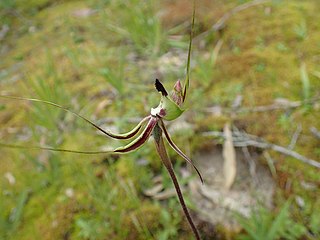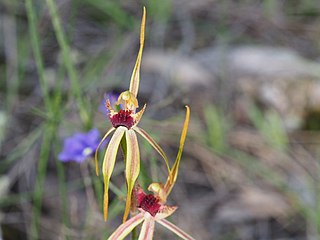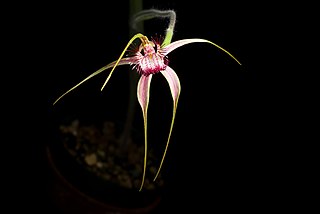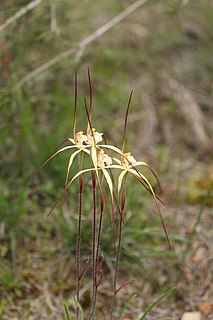
Caladenia paludosa, commonly known as the swamp spider orchid, is a species of orchid endemic to the south-west of Western Australia. It has a single erect, hairy leaf and up to three red, greenish-yellow and cream-coloured flowers. It mostly grows in dense scrub and is one of the last of the similar spider orchids to flower.

Caladenia plicata, commonly known as the crab-lipped spider orchid, is a species of orchid endemic to the south-west of Western Australia. It has a single hairy leaf and one or two red, yellow and pale green flowers with an unusual labellum which vibrates in the slightest breeze.

Caladenia lobata, commonly known as the butterfly orchid, is a species of orchid endemic to the south-west of Western Australia. It has a single, hairy leaf and one or two greenish-yellow flowers with red markings which have a labellum which vibrates in the slightest breeze.

Caladenia exstans, commonly known as the pointing spider orchid, is a species of orchid endemic to a small area in the south-west of Western Australia. It has a single, hairy leaf and one or two green, yellow and red flowers with a labellum which does not curl downwards but "points" forward.

Caladenia falcata, commonly known as the fringed mantis orchid, is a species of orchid endemic to the south-west of Western Australia. It is a relatively common orchid within its natural range and has a single, hairy leaf and one or two green, yellow and red flowers with spreading petals and upswept lateral sepals.

Caladenia georgei, commonly known as the tuart spider orchid, is a species of orchid endemic to the south-west of Western Australia. It has a single, hairy leaf and up to three whitish to yellowish-green flowers flushed with red and which have a white labellum with a red tip.
Caladenia graniticola, commonly known as the Pingaring spider orchid, is a species of orchid endemic to the south-west of Western Australia. It has a single, hairy leaf and one or two yellowish-green, red and white flowers which have a greenish-yellow and white labellum with a red tip. It was originally described as Caladenia hoffmanii subsp. graniticola but has a slightly different labellum and column.
Caladenia hoffmanii, commonly known as Hoffman's spider orchid is a species of orchid endemic to the south-west of Western Australia. It has a single, hairy leaf and one or two, greenish-yellow, red and white flowers which have a greenish-yellow labellum with a red tip. It is distinguished from the Pingaring spider orchid by small differences in the labellum and more northerly distribution.

Caladenia horistes, commonly known as the cream spider orchid is a species of orchid endemic to the south-west of Western Australia. It has a single, hairy leaf and one or two, creamy-yellow flowers which have a red-striped labellum and long, dark, thread-like tips on the sepals and petals.
Caladenia incrassata, commonly known as the puppet clown orchid is a species of orchid endemic to the south-west of Western Australia. It has a single, hairy leaf and usually only one greenish-yellow and red flower which has a red-striped labellum.

Caladenia longiclavata, commonly known as the clubbed spider orchid is a species of plant in the orchid family, Orchidaceae and is endemic to the south-west of Western Australia. It is a widespread and common orchid with a single, hairy leaf and one or two greenish-yellow, white and red flowers and which grows in the area between Perth and Albany.

Caladenia macrostylis, commonly known as the leaping spider orchid, is a species of orchid endemic to the south-west of Western Australia. It has a single, hairy leaf and up to three distinctive pale greenish-yellow and red flowers with a cluster of deep purplish calli in the centre of its labellum.

Caladenia procera, commonly known as the Carbunup king spider orchid, is a species of orchid endemic to the south-west of Western Australia. It has a single erect, hairy leaf and up to four greenish-yellow and red flowers. It is one of the tallest and has amongst the largest flowers of the spider orchids.

Caladenia rhomboidiformis, commonly known as the diamond spider orchid, is a species of orchid endemic to the south-west of Western Australia. It has a single erect, hairy leaf and one or two green, yellow and red flowers. Until 1971 It was known as a variety of the green comb spider orchid Caladenia dilatata then, until 1989 as a variety of the clubbed spider orchid, Caladenia longiclavata.

Caladenia serotina, commonly known as the Christmas spider orchid, is a species of orchid endemic to the south-west of Western Australia. It has a single erect, hairy leaf and up to three white to cream-coloured and red flowers, although the relative amount of each is variable. It is one of the later-flowering spider orchids and occurs in the far south-west corner of the state.

Caladenia thinicola, commonly known as the Scott River spider orchid, is a species of orchid endemic to the south-west of Western Australia. It has a single erect, hairy leaf and up to four yellowish-green and red flowers with a fringe of long teeth on the sides of the labellum and thick brown, club-like glandular tips on the sepals.

Caladenia uliginosa subsp. uliginosa, commonly known as the dainty spider orchid, or darting spider orchid is a plant in the orchid family Orchidaceae and is endemic to the south-west of Western Australia. It has a single hairy leaf and up to four greenish-cream flowers which have a forward-projecting labellum with a dark red tip.
Caladenia viridescens, commonly known as the Dunsborough spider orchid, is a species of orchid endemic to the south-west of Western Australia. It has a single erect, hairy leaf and up to three pale greenish-yellow flowers with faint red or pink markings.

Caladenia williamsiae, commonly known as Judy's spider orchid, or Williams' spider orchid is a species of orchid endemic to the south-west of Western Australia. It is a rare species with a single relatively large, erect, hairy leaf and one or two delicate, greenish-yellow and red flowers. It is only known from a single population near Brookton.

Caladenia xantha, commonly known as the primrose spider orchid, is a species of orchid endemic to the south-west of Western Australia. It has a single erect, hairy leaf and up to three yellow flowers with a cream-coloured, brown-striped labellum.

















